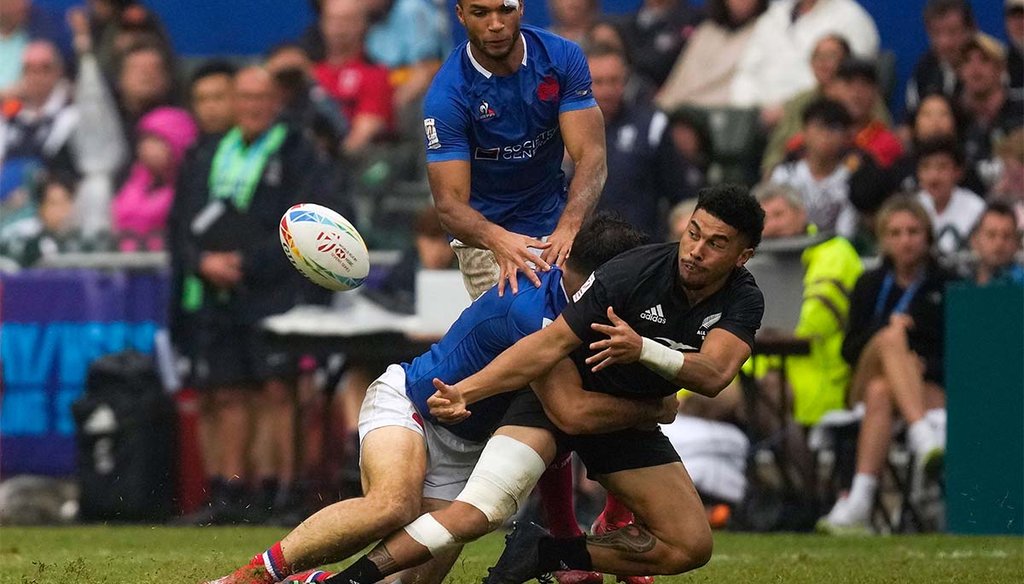Stand up for the facts!
Our only agenda is to publish the truth so you can be an informed participant in democracy.
We need your help.
I would like to contribute

New Zealand's Ngarohi McGarvey-Black passes the ball April 2, 2023, during the semifinals match against France in the Hong Kong Sevens rugby tournament. (AP)
Fact-checking Joe Biden on whether rugby is safer than football
If Your Time is short
• Much of the relevant academic research suggests that rugby results in higher rates of overall injuries and concussions than American football does — often two to three times higher.
• Some studies paint a more nuanced comparison in injury rates between the two sports.
• However, even the studies that point to more comparable rates suggest that injuries in rugby can be serious, both in real time and over a lifetime.
In a speech before the Irish parliament, President Joe Biden praised a sport more popular in Ireland than in the United States: rugby.
Biden told the assembled lawmakers April 13 that he keeps an autographed rugby ball used in a 2021 game in which Ireland’s team defeated New Zealand’s fabled All Blacks. He said it was given to him by "one of Ireland’s greatest rugby stars, Rob Kearney," during a St. Patrick’s Day visit in 2022.
Biden said he played a bit of rugby as a younger man, along with "American football and a few other sports." He said that, in retrospect, rugby might be a safer game.
"I’d rather have my children playing rugby now, for health reasons, than I would have them playing football," Biden said. "Fewer people get hurt playing rugby. And you have no equipment. You have 280-pound guys like we do, and you just don’t hit each other in the head very often."
Is Biden correct that rugby is a safer game than American football? Actually, most of the academic research suggests the opposite.
"While the risk of injury in collision sports is substantial, rugby tends to have more injuries overall and more concussions than American football," said Thomas Buckley, associate professor in the department of kinesiology and applied physiology at the University of Delaware. In addition, he said, "players in both sports tend to have higher rates of neurodegenerative diseases such as mild cognitive impairment and dementia."
First, a caveat: Comparing research on the two sports can be challenging because different metrics are used.
For instance, some papers we found used overall injury rates, while others looked exclusively at concussions. Some studies looked at emergency room admissions while others compared longer-term health conditions. Some looked at school-age players while others studied professionals. And not all studies equalized their research to account for practice time and time spent off the field during games, which can alter the comparison of the two sports.
It’s also worth noting for Americans unfamiliar with the sport that while American football players wear helmets and extensive padding, rugby uniforms involve far less protective padding and do not include a helmet.
The White House did not provide supporting evidence for Biden’s statement, but we found our own.
President Joe Biden addresses members of the Irish parliament on April 13, 2023. (New York Times via AP)
Meta-analyses
One type of study we came up with is called a meta-analysis, which looks at a wide range of existing studies and tries to draw broader conclusions about their collective findings.
Perhaps the leading meta-analysis, published in the journal Sports Medicine in 2021, looked at 83 studies. It found that rugby had the highest concussion rate of any sport, or about three times higher than the second-place sport, American football. The third- and fourth-place finishers were ice hockey and wrestling. Rugby was the only one of the sports studied that the authors labeled "high risk" based on these numbers.
Meanwhile, a 2015 study in the British Journal of Sports Medicine looked at 13 articles that addressed sports concussion rates. It found that rugby placed first, with a rate more than three times higher than ice hockey and eight times higher than American football.
In a less formal analysis of the academic literature published in the journal Injuries and Sports Medicine in 2013, the authors concluded that rugby "carries a significantly higher relative risk of injury than American football."
Direct-comparison studies
Direct-comparison studies are the closest thing to an apples-to-apples comparison.
One paper, published in 2016 in the American Journal of Sports Medicine, looked at NCAA Division I injuries over three seasons for both sports.
The authors found that the overall injury rate was about three times higher in rugby than in American football, and that a subset of this, the concussion rate, was about 2.5 times higher in rugby than in football. The authors deemed these differences to represent a "substantially higher" risk for rugby.
Another researcher with experience in the field wrote a letter to the editor that critiqued these conclusions. Hamish Kerr, now a professor of medicine and pediatrics at Albany Medical Center who has worked as a physician for both USA Rugby and World Rugby, wrote that the conclusion would flip if the methodology had taken into account that rugby players spend much more time on the field and engaging in athletic activity than football players do. This means that, adjusted for time played, rugby players’ injury rates would be lower.
A paper on collegiate play in both sports published in the British Journal of Sports Medicine by Kerr and several co-authors in 2008 supported that interpretation.
Meanwhile, another paper, published in the journal Craniomaxillofacial Trauma & Reconstruction in 2022, looked at data from a 20-year injury database and found that "there was no difference in the rate of hospital admission when comparing football and rugby."
However, this database would not capture injuries that didn’t rise to the level of a hospital admission.
Finally, a study published in the journal Sport Sciences for Health in 2022, looked at questionnaire responses from more than 2,000 Canadian high school students who had taken part in "collision-based sports," which included rugby, football, lacrosse and ice hockey. Here, the findings were somewhat mixed, though they still undercut Biden’s assertion that rugby was clearly a safer option than football.
In overall injuries, rugby scored lower than the three other sports studied; ice hockey was highest, with an injury rate 2.6 times higher than rugby, while football and lacrosse were in the middle.
It found the concussion data for rugby to be worrisome. Half of all injuries in rugby were concussions, more than twice the percentage in football, and the rate of concussions in rugby was slightly higher in rugby than in football.
A focus on concussions
Other research, while not directly comparing rugby and football, demonstrated concerns about the long-term effect of concussions among rugby players.
For years, American football has been grappling with the consequences of concussions on long-term neurological health, including the risk of chronic traumatic encephalopathy, also known as CTE. But rugby is also grappling with these concerns.
A 2022 paper in the Journal of Neurology, Neurosurgery and Psychiatry looked at 32 former rugby players and a control group of 381 nonrugby players over roughly three decades. While the mortality rate was slightly lower for the rugby players through age 70, the players were more than twice as likely as control group members to be diagnosed with neurodegenerative diseases.
Academic papers have found disproportionate evidence of CTE in both rugby and football players. As of this month, some 360 rugby players in the United Kingdom have joined a lawsuit against their sports leagues for not taking sufficient precautions against concussions.
Willie Stewart, a neuropathologist at Queen Elizabeth University Hospital in Glasgow, Scotland, who co-authored the paper in the Journal of Neurology, Neurosurgery and Psychiatry, said that such studies should be taken as persuasive evidence of rugby’s risks.
"Brains are the main issue we should worry about," Stewart said. "Knees and hips we can live with when damaged, or replace them. Brains we get a one-time supply of, and when damaged, it's irreparable and irreplaceable."
Our ruling
Biden said that "fewer people get hurt playing rugby" than American football.
Significant academic research suggests that rugby results in higher rates of overall injuries and concussions than American football does — often two to three times higher.
Other studies paint a more nuanced comparison in injury rates between the two sports. However, even these studies suggest that injuries from rugby can be serious, both in real time and over a lifetime.
We rate the statement Mostly False.
Our Sources
White House, "Remarks by President Biden to the Houses of the Oireachtas," Apr. 13, 2023
Kathryn L. Van Pelt, Tim Puetz, Jennylee Swallow, Andrew P. Lapointe, and Steven P. Broglio, "Data‑Driven Risk Classification of Concussion Rates: A Systematic Review and Meta‑Analysis" (Sports Medicine), 2021
Ted Pfister, Ken Pfister, Brent Hagel, William A Ghali, and Paul E Ronksley, "The incidence of concussion in youth sports: a systematic review and meta-analysis" (British Journal of Sports Medicine), 2015
Ravin Patel, Austin Wetzler, Nicholas Bennett and Merrick Wetzler, "Injuries in Rugby Union: A Review" (Injuries and Sports Medicine) 2022
Nienke W Willigenburg, James R Borchers, Richard Quincy, Christopher C Kaeding, and Timothy E Hewett, "Comparison of Injuries in American Collegiate Football and Club Rugby: A Prospective Cohort Study" (American Journal of Sports Medicine), 2016
H A Kerr, C Curtis, L J Micheli, M S Kocher, D Zurakowski, S P T Kemp, and J H M Brooks, "Collegiate rugby union injury patterns in New England: a prospective cohort study" (British Journal of Sports Medicine), 2008
Jordan Richardson, Dani Stanbouly, and Michael R. Markiewicz, "The Most Dangerous Game: A Review of Head and Neck Injuries in American Football and Rugby" (Craniomaxillofacial Trauma & Reconstruction), 2022
Hamish Kerr, "Collegiate Rugby Has Lower Injury Incidence Than American Football: Letter to the Editor" (American Journal of Sports Medicine), 2016
Stephen W. West, Mark. P. Pankow, Eric S. Gibson, Paul H. Eliason, Amanda M. Black, and Carolyn A. Emery, "Injuries in Canadian high school boys’ collision sports: insights across football, ice hockey, lacrosse, and rugby" (Sport Sciences for Health), 2022
Emma R Russell, Daniel F Mackay, Donald Lyall, Katy Stewart, John A MacLean, James Robson, Jill P Pell, and William Stewart, "Neurodegenerative disease risk among former international rugby union players" (Journal of Neurology, Neurosurgery and Psychiatry), 2022
Edward B. Lee, Kevin Kinch, Victoria E. Johnson, John Q. Trojanowski, Douglas H. Smith, William Stewart, "Chronic traumatic encephalopathy is a common co‑morbidity, but less frequent primary dementia in former soccer and rugby players" (Acta Neuropathologica), 2019
Michael B. Clay, Kari L. Glover, and Duane T. Lowe, "Epidemiology of concussion in sport: a literature review" (Journal of Chiropractic Medicine), 2013
Everett J Lehman, Misty J Hein, Sherry L Baron, and Christine M Gersic, "Neurodegenerative causes of death among retired National Football League players" (Neurology), 2012
Associated Press, "Nearly 400 ex-rugby, soccer players in concussion lawsuit," April 4, 2023
Email interview with Hamish Kerr, professor of medicine and pediatrics at Albany Medical Center, April 13, 2023
Email interview with Thomas Buckley, associate professor in the department of kinesiology and applied physiology at the University of Delaware, April 14, 2023
Email interview with Willie Stewart, neuropathologist at Queen Elizabeth University Hospital in Glasgow, Scotland, April 14, 2023
Browse the Truth-O-Meter
More by Louis Jacobson
Fact-checking Joe Biden on whether rugby is safer than football
Support independent fact-checking.
Become a member!
In a world of wild talk and fake news, help us stand up for the facts.











































